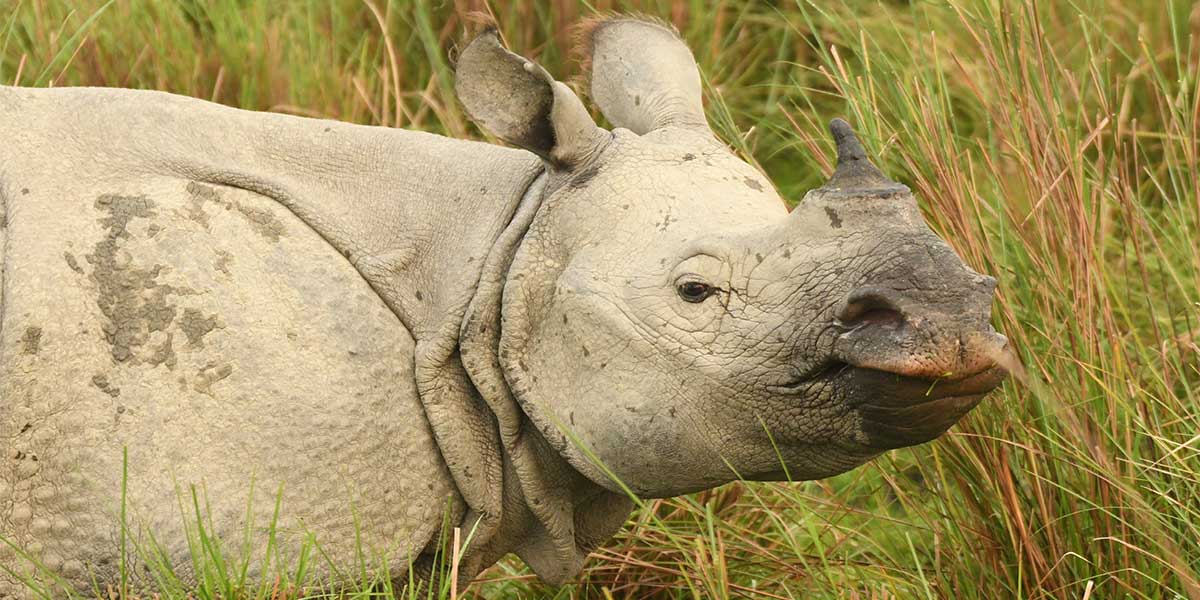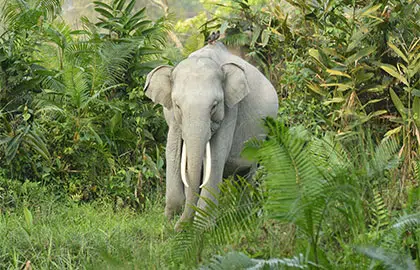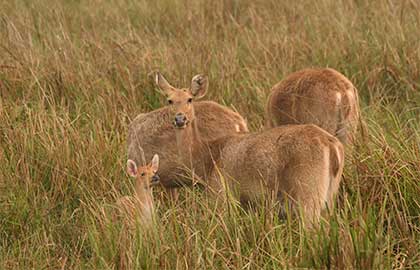Kaziranga National Park – A park that survives on an yearly flood
Overview
Kaziranga National Park is a renowned wildlife tourism destination located in Golaghat, Karbi Anglong and Nagaon districts of the state of Assam, India. The park is considered as a World Heritage site and is home to almost two thirds of the world’s great one-horned rhinoceroses. Due to its high density of tiger population among protected areas in the world, it was declared as a tiger reserve in 2006. The park is located at the cusp of the Eastern Himalaya biodiversity hotspot and is regarded as one of the most exceptional wildlife refuges in the world.

Information
Kaziranga National Park is a safe habitat for globally threatened species such as Royal Bengal tiger, Asian elephant, wild water buffalo, gaur and eastern swamp deer. It is vastly spread in an area of 430 sq kms and presents a massive range of natural beauty and scenic landscapes. The park is also a bird watcher’s paradise as it has been identified as an Important Bird Area and is home to a variety of migratory and inhabitant birds such as lesser white-fronted goose, ferruginous duck, Blyth’s kingfisher, white-bellied heron and many more. The vast expanse of dense and tall elephant grass mixed with moist broadleaf forests enhances the magnificence of this park and makes it a perfect retreat for nature lovers and adventure enthusiasts.
- Size – 430 sq kms
- Forest type – Tropical moist mixed deciduous forests and tropical semi-evergreen forests
Star Species
The best time to visit Kaziranga National Park is between the months of November and April as the park’s charm is at its peak, ready to take you under its wings to give you an experience like no other. In order to have the finest experience while visiting the park, the most pragmatic choice would be to live in a resort in Kaziranga National Park as it allows you to savour the adventure as an insider thereby adding depth to your observations and overall experience.
- Key Mammals – Great one-horned rhinoceroses, Royal Bengal tiger, Asian elephant, Wild Water buffalo, Gaur, Eastern swamp deer, Sambar, Pangolin
- Key Birds – Lesser white-fronted goose, ferruginous duck, Blyth’s kingfisher, white-bellied heron, Pallas’s fish eagle, grey-headed fish eagle
How to reach
- By train – The nearest railway station from Kaziranga National Park is Furkating station that is 75 kms away and is connected by train to other major cities such as Guwahati, Kolkata and Delhi. Guwahati station is the nearest major railway station that is 200 kms away from the park and enjoys good rail connectivity to the rest of the country.
- By Air – The nearest airport from the park is Rowriah Airport, located at a distance of almost 74km in Jorhat, Assam. The second nearest is Dimapur airport which is situated at a distance of almost 83 kms in Dimapur, Nagaland.
- By road – There are a lot of buses that operate from Guwahati, Tezpur, Dimapur and Upper Assam and pass through Kohara which is the nearest bus stop to reach Kaziranga. Local transport services such as cabs or taxis also run and join Kohara from other nearby small cities and towns.
Safari
This National Park is divided into 4 Ranges:
- Burapahar : Ghorakati
- Western Range : Bagori
- Central Range : Kohora
- Eastern Range : Agoratli
Note: Please check with us for elephant safari details.
Weather and Climate
| Month | Minimum°C | Maximum°C |
| Jan | 10.4 | 23.7 |
| Feb | 12.8 | 25.5 |
| Mar | 16.4 | 29.4 |
| Apr | 19.8 | 30.9 |
| May | 22.4 | 30.9 |
| Jun | 24.8 | 32.1 |
| Jul | 25.3 | 32.6 |
| Aug | 25.4 | 32.6 |
| Sept | 24.6 | 31.9 |
| Oct | 21.7 | 30.4 |
| Nov | 16.2 | 27.6 |
| Dec | 11.8 | 24.6 |
Things to carry
Clothing tips for the right safari experience:
- Clothes in the earthy colours to be worn which are greens, beige and grey. Black attracts mosquitoes and should be avoided. Shiny or bright colours are a big no.
- Clothes as per expected weather are very important:
- Summer clothes to be carried should be preferably cotton or cotton blend that is comfortable, and breathable.
- Winter clothes to be packed should be planned for layering over each other when worn. Advisably 4-5 woollen clothes than one heavy item.
- A raincoat or a windcheater is also recommended.
- A hat or a cap as per the weather or season is also prescribed.
- Avoid wearing strong fragrances on the safari.
Gallery




